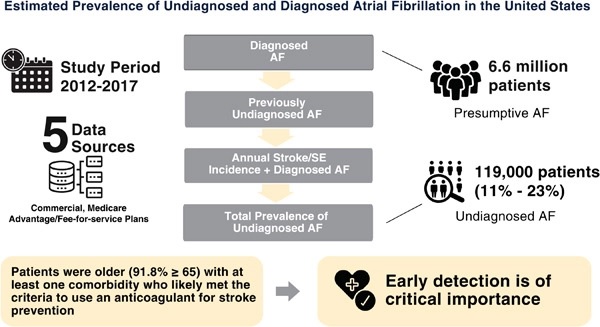Atrial fibrillation (AF) is the most common arrhythmia in the United States. AF is associated with considerable morbidity and mortality caused by related heart failure and ischemic stroke.
To date, estimates of the prevalence of AF have varied widely, from approximately 1% to 2% of the general US population. However, these estimates have been based primarily on clinically diagnosed AF seen in analysis of cohorts, surveys and claims. Such estimates are hampered by challenges in diagnosing AF and are likely to be underestimated as many patients have paroxysmal, asymptomatic, or subclinical cases. To date, detection has been primarily opportunistic; Furthermore, previous studies have been hampered by cost considerations and limited to small convenience samples that do not support generalizable overall prevalence estimates.
Another barrier to determining the prevalence of AF is the presence of undiagnosed AF . Cases of undiagnosed AF are especially challenging, as it is estimated that around one-third of the AF population is asymptomatic. As such, it is often hospitalization for acute symptoms such as ischemic stroke that brings them to light. There is increasing evidence of significant proportions of undiagnosed AF cases in the United States and Europe. A previous study provided a novel methodology to estimate the prevalence of AF, including undiagnosed cases, in a large data set setting. This methodology recalculates the prevalence of undiagnosed AF by linking an AF diagnosis to a previous stroke, which is the primary reason why patients with undiagnosed AF are diagnosed. However, these studies, including the one using the retrospective calculation method, have been limited in size and generalizability of the study population. Therefore, comprehensive characterization of the overall prevalence of undiagnosed AF, particularly in the United States, remains elusive.
To address this evidence gap, we conducted this study to estimate the prevalence of undiagnosed and diagnosed AF, by applying the previously used retrospective estimation methodology to population-level data from an integrated commercial claims data set of Big and diverse USA.

Background
Atrial fibrillation (AF) prevalence estimates vary and have been based on cohorts with clinically established or diagnosed disease. Prevalence estimates of undiagnosed AF are less certain, as they are based on non-generalizable convenience samples.
Hypothesis
Because AF is often asymptomatic, it may not be diagnosed until complications such as stroke or heart failure occur. Consequently, the observed prevalence of diagnosed AF in the literature may underestimate the total burden of the disease. Therefore, we sought to estimate the total prevalence of both diagnosed and undiagnosed AF.
Methods
We conducted a retrospective cohort study from 2012 to 2017 using data from five US medical claims datasets. The prevalence of undiagnosed AF was estimated based on the observed incidence of ischemic stroke, systemic embolism (SE), and incidence of AF after stroke/EE.
The diagnosed AF cohort included patients with AF between the first quarter of 2014 and the third quarter of 2015. The undiagnosed AF cohort consisted of patients with AF presumed not diagnosed in the year before a stroke/SE and who were They had just been diagnosed with AF within 3 months of stroke/SE.
The incidence of stroke/SE was calculated among all AF patients and the relationship between the number of undiagnosed AF patients and the stroke rate was created. Age- and sex-adjusted estimates were stratified by the period of presumed undiagnosed AF before post-stroke/SE AF diagnosis (1 or 2 years).
Results
The estimated prevalence of AF in the US (diagnosed and undiagnosed) in the third quarter of 2015 was 5,628,000 cases, of which 591,000 cases (11%) were undiagnosed.
The assumed prevalence of undiagnosed AF at 2 years was 23% (1,531,000) of the total prevalent patients with AF (6,568,000). Undiagnosed (vs. diagnosed) AF patients were older and had higher CHA2DS2-VASc scores. Of undiagnosed AF, 93% had CHA2DS2-VASc ≥2 and met OAC criteria.
Conclusions Our study adds updated data to characterize undiagnosed AF nationally in the United States. The data we generated from retrospective calculation suggest considerable proportions of undiagnosed patients , in the context of increasing overall prevalence, with diagnosed cases increasing from 3.7 to 5 million in 2 years and up to 1.5 million presumptive cases undiagnosed at the end of that period. Coupled with the known burden of AF, this growing unmet need underscores the critical importance of early detection. Our data can support both disease surveillance and future research and policy initiatives. These contemporary estimates demonstrate the high prevalence of undiagnosed AF in the United States. Undiagnosed atrial fibrillation patients primarily consist of elderly individuals who, if diagnosed, would meet criteria for stroke prevention therapy. |















